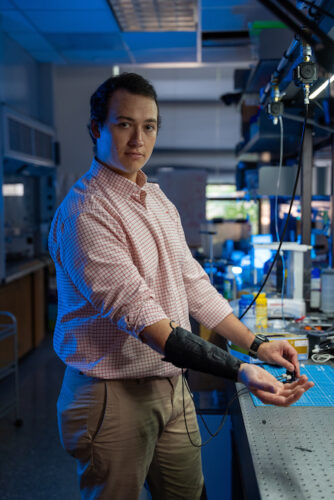Image Courtesy of Brandon Martin/Rice University.
Personal devices that stimulate our sight and hearing have skyrocketed in development over the past few decades; however, this has left our sense of touch, ironically, untouched. A textile-based touch-influenced haptic device developed by mechanical engineers at Rice University sets to bring a new dawn to the wearable accessory industry. Inspired to assist those around the world with visual and hearing impairments, these researchers wish to use the sense of touch to revitalize accessible communication.“Around a billion people suffer from loss of hearing or loss of vision,” said Barclay Jumet, a mechanical engineering PhD student who is the lead author of the study published in Device. “We wanted to address these concerns through a last-resort pathway of communication—the sense of touch, or haptics.”
Composed of multiple fluid-based cells, these wearables can be easily applied to a user’s forearm. The cells generate point-force cues, where users will feel gentle taps with half-second delays that go down their arms as they come into contact with various obstacles and dynamic environments. Moreover, these heat-sealable textiles are resilient to wear and tear, making them ideal for daily use.
Instead of using voltage and current, these wearable devices utilize the flow of fluids, enabling researchers to program soft materials without using electronics. Fluidic signals—such as pressures and flow rates—help control the delivery of complex haptic cues, including sensations like vibration, tapping, and squeezing. A small, lightweight carbon dioxide tank affixed to the wearable feeds airtight circuits within the device, causing quarter-sized pouches—up to six on each sleeve—to inflate with varying force and frequency.
Extraordinarily, these devices are also extremely user-friendly. “We’re extremely excited to introduce intuitive feeling cues into this device,” said Daniel J. Preston, assistant professor of mechanical engineering at Rice University and corresponding author of the study. “For example, if we want to tell someone to go forward or to the left or right, we introduce patterns in the point-force cues that feel natural to the user—essentially, they are inclined to move in those directions, as opposed to having to learn how to interact with the haptic device.” These parameters can also be adjusted based on the user’s desired applications for the wearable.
Building on their approach from previous research related to textile logic, the Rice researchers faced little struggle in developing this haptic device. “In one of our prior publications, we implemented digital logic circuits to introduce memory storage and decision-making into wearables,” said Preston. “We were in a good position to translate this knowledge to the haptic domain, building this wearable that can deliver various navigation cues.”
In the future, Jumet and Preston aim to expand the application of their wearable device into clinical and everyday settings. “Surgeons could benefit from the enhanced training regimen that haptics enables,” said Jumet. “Everyday people like ourselves could also enjoy entertainment like movies or games to a greater degree by having this additional dimension of touch added to these activities.” The applications of touch-based devices are broad, and their introduction to the broader public could be closer than we think.

